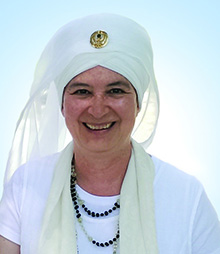by Dr. Shanti Shanti Kaur Khalsa and Dr. Sat-Kaur Khalsa
We are in a time where many of us are experiencing multiple losses: Our daily life as we have known it due to a potentially fatal disease, serious questions about our teacher whether one believe those questions or not, learning about our children’s experience with schooling in India, exposing racial injustices, and other personal losses we may experience during this tumultuous time. Because of these losses, we are individually and collectively experiencing deep and profound grief.
Our intention for offering this document is to provide a guide for individuals and the leaders of our organizations to assess where we might be in the grieving process. It may be a helpful way to explore how grief can ultimately serve the process of transformation. When we do grief work well, there is a solid footing for the future.
The poet Paul Monette described his experience of grief as a sword that cuts through any illusions about life and who we are. Like a spiritual sword, grief can take us directly through the pain of the mind and heart and lead us to the joy and infinity of the soul.
This guide is a non-linear model. We move in and out of the various stages. We recognize that it is vital for people to have the opportunity to experience these stages in whatever time frame best meets their needs, in order to allow for the spectrum of grief response.
The Grief Process
Shock – One can feel confused, paralyzed, or be unable to act or think clearly. Shock is most typically an initial response but can be delayed. Additional information or upsetting events could cause this stage to reoccur.
Denial – Characterized by clinging to what was, unable to accept the information that caused the response.
Numbness – Characterized by “checking out” or shutting down emotionally. Inability to feel or to express emotion. Feeling a sense of heaviness in the body. Can evolve into depression.
Destabilization / Falling Apart – Characterized by wide swings of emotion that can include anger, fear, depression, sadness, emotional reactivity, confusion, self-doubt, inability to focus, and a sense of loss. This can be experienced by both individuals and communities/organizations. May include dealing with underlying guilt, shame, and/or resentment. It is recommended to refrain from making major life changing decisions for at least a year from the initial event(s).
Grief is like water; it has to move or it stagnates. Nothing identifies, releases, or transforms emotional pain as quickly or completely as mantra. The most direct way to do this is through the sound current by consistently chanting in the company of the Sadh Sangat. If circumstances prohibit this, you can chant out loud on your own, with your family or join virtual offerings. Heart-centered healing mantras like Guru Guru Wahe Guru, Guru Ram Das Guru are helpful. Applying mantra to the grief process provides clearing of emotional attachment to the past and an awakening of what is possible now.
Grief Recovery as the Integration of Change
Grief recovery begins with recognition that one’s life and circumstances are not going to return to the way they were and an acknowledgement of, or an allowing for, the integration of the change. A conscious decision to actively participate in this integration initiates the process of grief recovery.
In order to be able to move effectively from the experience of grief into grief recovery, it is essential to first raise your Shakti/vitality/energy and to elevate your spirit.
Below are the tasks and decisions that support and facilitate the integration of change. Although multiple losses may be concurrent and/or interrelated, it is helpful to identify and process each loss one at a time.
- Observation & Re-Evaluation – A time of self-reflection. A time of re-evaluation of beliefs, decisions and priorities. A time to examine what is important to you now. You may ask, “What is the loss? What is different now? What do I still value and what do I want to bring into my future?”
Allow yourself to be aware of what is different about you, not only what is different in your circumstances. Notice what is emerging or transforming within.
- Honor Your History & Recalibrate to Authentic Self – It is important to acknowledge and accept what has brought you to where you are now, possibly by creating a ritual of sorts to say goodbye to the past and recognize the changes. It is a time for recalibration of who you are becoming in order to emerge as more of your authentic self.
- Visioning for Your Future – Creating a vision or image for yourself as a guide or compass point into the future. The vision integrates your awareness of what is emerging and transforming and your self-reflection and honoring of the past.
- Decisions and actions to manifest that vision – Looking at possible steps towards the manifestation of your vision.
- Integration of these changes into your identity – Stilling one’s self and being at peace within oneself in order to fully embrace the integration of change.
- Moving forward with your life with more ease and joy – Emerging and being your authentic self.
It is our hope that this information proves helpful to you in this time of change.

Shanti Shanti Kaur brings the ancient teachings of Kundalini Yoga into modern medicine as Founding Director of the Guru Ram Das Center for Medicine & Humanology. A Kundalini Yoga teacher since 1971, Dr. Khalsa began to specialize in teaching Kundalini Yoga and meditation to people with chronic or life-threatening illness and their family members in 1986. She is a Certified Yoga Therapist, a Mentoring Lead Trainer for Levels 1 and 2 Kundalini Yoga teacher training, a Medical Family therapist, and a charter member of the International Association of Yoga Therapists.

Dr. Sat-Kaur Khalsa is a renowned psychotherapist and counselor in private practice in Santa Monica, California and Santa Fe, New Mexico. She is a licensed Marriage and Family Therapist in California and New Mexico as well as a licensed Clinical Mental Health Counselor in New Mexico. Since 1983, Dr. Khalsa has served clients from all areas of the entertainment industry, as well as professionals, entrepreneurs, homemakers, athletes, and spiritual seekers.
She received her Doctorate of Education (combining psychology, counseling, administration, and education) from the University of California, Berkeley. She earned her Masters of Education (specializing in College Level Counseling) from Northeastern University, Boston, Massachusetts, and her Bachelor of Science from Boston University, Boston, Massachusetts.
Dr. Sat-Kaur is a member of the California Association of Marriage and Family Therapists/CAMFT. She a KRI-certified Kundalini Yoga teacher, facilitates White Tantric Yoga® courses and is the published author of Sacred Sexual Bliss: A Technology for Ecstasy.
